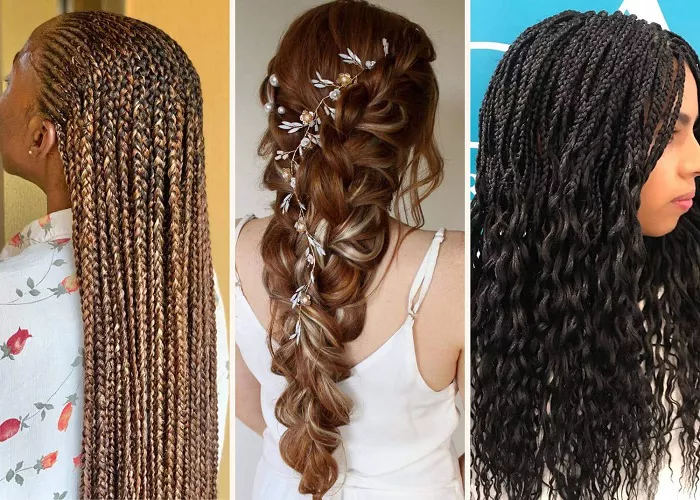As a hairstylist, I’ve seen countless trends come and go, but knotless braids have truly captured the attention of many. They offer a stylish, low-maintenance, and protective hairstyle that is perfect for anyone looking to give their hair a break while still looking fabulous. In this article, we’ll dive deep into what knotless braids are, how they differ from traditional braids, and why they’ve become such a popular choice.
What Are Knotless Braids?
Knotless braids are a modern and innovative take on traditional braiding hairstyles. Unlike regular box braids that start with a knot at the root, knotless braids use a feed-in technique, meaning they begin with your natural hair and gradually incorporate synthetic hair extensions as the braid progresses. This method eliminates the tight knots that can cause tension and damage to the scalp, making knotless braids a more comfortable and gentle option.
How Knotless Braids Differ from Traditional Box Braids
Traditional box braids are created by starting the braid with synthetic hair at the root, which can sometimes lead to scalp tension and discomfort. Knotless braids, on the other hand, start with your natural hair and only introduce synthetic hair after the first inch or so. This technique results in a more natural look and feel, with less strain on the scalp.
Benefits of Knotless Braids
Less Scalp Tension: One of the most significant advantages of knotless braids is the reduced tension on the scalp. Since there are no knots at the root, there’s less pulling and discomfort, making them a great choice for those with sensitive scalps.
Lightweight and Comfortable: Knotless braids use fewer synthetic hair extensions compared to traditional braids, making them lighter and less bulky. This means you can wear them without feeling weighed down.
Natural Appearance: The feed-in technique gives knotless braids a seamless and natural look. They blend seamlessly with your natural hair, making them an excellent choice for those who want a more understated style.
Versatility in Styling: Knotless braids offer a wide range of styling options. You can wear them down, pull them back into a ponytail, or even create intricate updos.
Longevity: With proper care, knotless braids can last up to six to eight weeks, making them a low-maintenance protective style.
Easy to Remove: Removing knotless braids is a breeze. You simply snip the synthetic hair at the base where it meets your natural hair and gently unravel the braids.
How to Install Knotless Braids
Installing knotless braids requires a bit of skill and patience, but the process is straightforward once you get the hang of it.
Here’s a step-by-step guide:
Prepare Your Hair: Start with clean, detangled hair. Divide your hair into sections using a rat-tail comb. The size of the sections will determine the thickness of your braids.
Begin the Braid: Take a section of your natural hair and divide it into three equal parts. Start braiding as you normally would.
Feed in Synthetic Hair: After braiding about ½ to 1 inch of your natural hair, add a small strand of synthetic hair extension. Continue braiding, incorporating more synthetic hair as you go.
Secure the Braid: Once you reach the desired length, secure the braid with a small elastic band. Repeat the process for each section of your hair.
Tips for Achieving Perfect Knotless Braids
Use Quality Hair Extensions: Opt for high-quality synthetic hair extensions that match your natural hair texture and color. Pre-stretched kanekalon hair is a popular choice.
Keep Braids Tight: Ensure that the braids are tight and close to the scalp to prevent them from unraveling.
Smooth the Edges: Use a small amount of edge control or gel to smooth down any flyaways around your hairline.
When to Remove Knotless Braids
While knotless braids can last up to eight weeks, it’s best to remove them after six weeks to prevent hair breakage and promote healthy hair growth. To remove the braids, carefully snip the synthetic hair at the base and gently unravel the braids.
Popular Knotless Braid Styles
Knotless braids offer endless styling possibilities. Here are some popular options:
Medium-Length Knotless Braids: These are perfect for everyday wear and can be easily styled into ponytails or buns.
Long, Flowing Braids: For a more dramatic look, opt for long, flowing knotless braids that can be worn down or styled into updos.
Curly Ends: Add a touch of flair by curling the ends of your knotless braids with a curling iron or using pre-curved synthetic hair.
Beaded Braids: Enhance your knotless braids with beads for a stylish and unique look.
Tribal-Inspired Patterns: Create intricate patterns and designs at the scalp for a culturally inspired style.
Conclusion
Knotless braids have revolutionized the world of protective hairstyles by offering a comfortable, low-maintenance, and stylish alternative to traditional box braids. With their seamless appearance, reduced scalp tension, and versatility in styling, knotless braids are perfect for anyone looking to protect their natural hair while still making a fashion statement.
Whether you’re a hairstylist or someone trying out a new style at home, knotless braids are a fantastic option. They provide a protective style that lasts long, looks great, and feels comfortable. So go ahead and give knotless braids a try—you won’t be disappointed!
Related topics:
How To Keep Your Curly Hair Straight All Day?
How to Cut a Layered Pixie Bob
What Short Haircuts Are In Style


